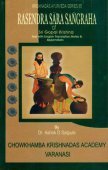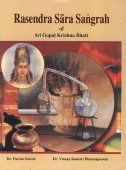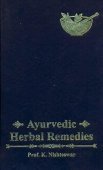Pradara: 15 definitions
Introduction:
Pradara means something in Hinduism, Sanskrit, Marathi, Hindi. If you want to know the exact meaning, history, etymology or English translation of this term then check out the descriptions on this page. Add your comment or reference to a book if you want to contribute to this summary article.
Alternative spellings of this word include Pradar.
In Hinduism
Ayurveda (science of life)
Kalpa (Formulas, Drug prescriptions and other Medicinal preparations)
Source: Shodhganga: Edition translation and critical study of yogasarasamgrahaPradara (प्रदर) refers to “menorrhagia” and is one of the various diseases mentioned in the 15th-century Yogasārasaṅgraha (Yogasara-saṅgraha) by Vāsudeva: an unpublished Keralite work representing an Ayurvedic compendium of medicinal recipes. The Yogasārasaṃgraha [mentioning pradara] deals with entire recipes in the route of administration, and thus deals with the knowledge of pharmacy (bhaiṣajya-kalpanā) which is a branch of pharmacology (dravyaguṇa).
Unclassified Ayurveda definitions
Source: archive.org: Science And Technology In Medievel India (Ayurveda)Pradara (प्रदर) or Pradaranidāna refers to one of the topics dealt with in the Vaidyakagrantha, as mentioned in A. Rahman’s Science and Technology in Medievel India: A bibliography of source materials in Sanskrit, Arabic and Persian.—Ancient and medieval India produced a wide range of scientific manuscripts and major contributions lie in the field of medicine, astronomy and mathematics, besides covering encyclopedic glossaries and technical dictionaries.—Pradara-nidāna and other sections of the Vaidyakagrantha deal with pathology and allied topics.

Āyurveda (आयुर्वेद, ayurveda) is a branch of Indian science dealing with medicine, herbalism, taxology, anatomy, surgery, alchemy and related topics. Traditional practice of Āyurveda in ancient India dates back to at least the first millenium BC. Literature is commonly written in Sanskrit using various poetic metres.
Languages of India and abroad
Marathi-English dictionary
Source: DDSA: The Molesworth Marathi and English Dictionarypradara (प्रदर).—m (S) Irregular or excessive menstruation, menorrhagia. It is disting. into raktapradara & śvētapra- dara, and, as further forms, into kṛṣṇapradara, dhātupradara, pūyapradara, pūyābha, raktapradara.
Source: DDSA: The Aryabhusan school dictionary, Marathi-Englishpradara (प्रदर).—m Irregular or excessive men- struation, menorrhagia.
Marathi is an Indo-European language having over 70 million native speakers people in (predominantly) Maharashtra India. Marathi, like many other Indo-Aryan languages, evolved from early forms of Prakrit, which itself is a subset of Sanskrit, one of the most ancient languages of the world.
Sanskrit dictionary
Source: DDSA: The practical Sanskrit-English dictionaryPradara (प्रदर).—
1) Rending, tearing.
2) (a.) A fracture, crack, cleft, crevice, chasm; इत्युक्त्वा लक्ष्मणं रामः प्रदरः खन्यतामिति (ityuktvā lakṣmaṇaṃ rāmaḥ pradaraḥ khanyatāmiti) Rām.3.4.12; सीमानः प्रदरोदरेषु विरलस्वच्छाम्भसः (sīmānaḥ pradarodareṣu viralasvacchāmbhasaḥ) Uttararāmacarita 2.16. (b) Breach, hole.
3) The dispersion of an army; न सन्निपाते प्रदरं वधं वा कुर्युरीदृशाः (na sannipāte pradaraṃ vadhaṃ vā kuryurīdṛśāḥ) Mahābhārata (Bombay) 12.1.34.
4) An arrow; त्रीण्येव च प्रदराणां स्म पार्थ (trīṇyeva ca pradarāṇāṃ sma pārtha) Mahābhārata (Bombay) 8.76.16.
5) A kind of disease of women.
Derivable forms: pradaraḥ (प्रदरः).
Source: Cologne Digital Sanskrit Dictionaries: Shabda-Sagara Sanskrit-English DictionaryPradara (प्रदर).—m.
(-raḥ) 1. Splitting, rending, tearing. 2. Fracturation, breaking. 3. The dispersion of an army. 4. A disease of women, (Mænorrhagia.) 5. An arrow. E. pra intensitive, dṛ to tear, aff. ap .
Source: Cologne Digital Sanskrit Dictionaries: Benfey Sanskrit-English DictionaryPradara (प्रदर).—i. e. pra-dṛ10 + a, m. 1. Scattering, Mahābhārata 12, 3715 (an army). 2. A cleft, [Uttara Rāmacarita, 2. ed. Calc., 1862.] 43, 6. 3. Fracture. 4. An arrow.
Source: Cologne Digital Sanskrit Dictionaries: Cappeller Sanskrit-English DictionaryPradara (प्रदर).—[masculine] splitting, rending; crack, crevice.
Source: Cologne Digital Sanskrit Dictionaries: Monier-Williams Sanskrit-English Dictionary1) Pradara (प्रदर):—[=pra-dara] a See pra-√dṝ.
2) [=pra-dara] [from pra-dṝ] b m. dispersion, rout (of an army), [Mahābhārata]
3) [v.s. ...] a crevice, cleft (in the earth), [Vājasaneyi-saṃhitā; Brāhmaṇa] etc.
4) [v.s. ...] menorrhagia (a disease of women), [Caraka]
5) [v.s. ...] a kind of arrow, [Mahābhārata]
6) [v.s. ...] rending, tearing, [Horace H. Wilson]
7) [v.s. ...] [plural] Name of a people, [Mahābhārata]
Source: Cologne Digital Sanskrit Dictionaries: Yates Sanskrit-English DictionaryPradara (प्रदर):—[pra-dara] (raḥ) 1. m. Splitting; fracture; an arrow; mænorrhagia.
Source: DDSA: Paia-sadda-mahannavo; a comprehensive Prakrit Hindi dictionary (S)Pradara (प्रदर) in the Sanskrit language is related to the Prakrit word: Payara.
[Sanskrit to German]
Sanskrit, also spelled संस्कृतम् (saṃskṛtam), is an ancient language of India commonly seen as the grandmother of the Indo-European language family (even English!). Closely allied with Prakrit and Pali, Sanskrit is more exhaustive in both grammar and terms and has the most extensive collection of literature in the world, greatly surpassing its sister-languages Greek and Latin.
Hindi dictionary
Source: DDSA: A practical Hindi-English dictionaryPradara (प्रदर) [Also spelled pradar]:—(nm) moenorrhagia (a disease of women).
...
Kannada-English dictionary
Source: Alar: Kannada-English corpusPradara (ಪ್ರದರ):—
1) [noun] the act of reaving, breaking, splitting or tearing.
2) [noun] a long, narrow, deep cleft; a crack; a fissure.
3) [noun] an arrow (which splits the object, when shot).
4) [noun] abnormally profuse menstrual flow; maenorrhagia.
5) [noun] a dispersion of an army, in fear or facing defeat.
Kannada is a Dravidian language (as opposed to the Indo-European language family) mainly spoken in the southwestern region of India.
See also (Relevant definitions)
Starts with: Pradarana, Pradaranidana.
Ends with: Puyapradara, Raktapradara, Shveta-pradara, Shvetapradara.
Full-text: Payara, Pradala, Raktapradara, Pradar, Shvetapradara, Puyabha, Shveta, Patara, Swet, Pratara, Vanga, Shvabhra.
Relevant text
Search found 11 books and stories containing Pradara, Pra-dara; (plurals include: Pradaras, daras). You can also click to the full overview containing English textual excerpts. Below are direct links for the most relevant articles:
Shishupala-vadha (Study) (by Shila Chakraborty)
Daṇḍa-vyūha (Staff array) < [Chapter 6 - Principles of Warfare]
Various other Arrays < [Chapter 6 - Principles of Warfare]
Nitiprakasika (Critical Analysis) (by S. Anusha)
Atharvaveda and Charaka Samhita (by Laxmi Maji)
Gynecic disorders and Impotency < [Chapter 4 - Diseases and Remedial measures (described in Caraka-saṃhitā)]
Rasendrasāra Saṅgraha (Āyurveda book) < [Chapter 1 - Introduction]
Yogaratnākara (Āyurveda book) < [Chapter 1 - Introduction]
The Garuda Purana (by Manmatha Nath Dutt)
Chapter CLXXIII - The Nidanam of diseases of the female reproductive organs < [Dhanvantari Samhita]
Kautilya Arthashastra (by R. Shamasastry)
Chapter 6 - The Array of the Army < [Book 10 - Relating to War]
Mahabharata (English) (by Kisari Mohan Ganguli)
Related products


